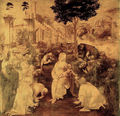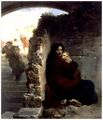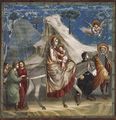Difference between revisions of "Category:Nativity of Jesus (subject)"
| (36 intermediate revisions by the same user not shown) | |||
| Line 1: | Line 1: | ||
[[File:Annunciation Rossetti.jpg|thumb|250px|[[Annunciation to Mary]] (Rossetti, 1850)]] | |||
[[File:Annunciation Joseph Gandolfi.jpg|thumb|250px|[[Annunciation to Joseph]] (Gandolfi, 1790)]] | |||
[[File:Visitation2 Pontormo.jpg|thumb|250px|[[Visitation of Mary]] (Pontormo, 1529)]] | |||
[[File:Birth Jesus Repin.jpg|thumb|250px|[[Birth of Jesus]] (Repin, 1894)]] | |||
[[File:Adoration Shepherds Murillo.jpg|thumb|250px|[[Adoration of the Shepherds]] (Murillo, 1668)]] | |||
[[File:Adoration Magi Leonardo.jpg|thumb|250px|[[Adoration of the Magi]] (Leonardo, 1482)]] | |||
[[File:Circumcision Mantegna.jpg|thumb|250px|[[Circumcision of Jesus]] (Mantegna, 1461)]] | |||
[[File:Presentation Jesus Eeckhout.jpg|thumb|250px|[[Presentation of Jesus at the Temple]] (Eeckhout, 1671)]] | |||
[[File:Innocents Cogniet.jpg|thumb|250px|[[Massacre of the Innocents]] (Cogniet, 1834)]] | |||
[[File:Flight Egypt Giotto.jpg|thumb|250px|[[Flight into Egypt]] (Giotto, 1306)]] | |||
*[[:Category:Events|BACK to the EVENTS--INDEX]] | |||
*[[Jesus|BACK to the JESUS--INDEX]] | |||
''' Nativity of Jesus ''' refers to a series of episodes in the lives of [[Jesus of Nazareth]] and [[Mary of Nazareth]], associated with Jesus' birth at [[Bethlehem]], as narrated in the gospels of Matthew and Luke, and later Christian tradition. | |||
* [[Genealogy of Jesus]] -- [[Annunciation to Mary]] -- [[Annunciation to Joseph]] -- [[Visitation of Mary]] -- [[Birth of Jesus]] -- [[Adoration of the Shepherds]] -- [[Adoration of the Magi]] -- [[Circumcision of Jesus]] -- [[Presentation of Jesus at the Temple]] -- [[Massacre of the Innocents]] -- [[Flight into Egypt]] | |||
* Cf. [[Madonna and Child]] -- [[Joseph and Jesus]] -- [[Holy Family]] | |||
< ''[[Life of Jesus]]'' : [[Nativity of Jesus]] -- [[Childhood of Jesus]] -- [[Jesus' Hidden Years]] -- [[Ministry of Jesus]] ([[Parables of Jesus]], [[Miracles of Jesus]]) -- [[Passion of Jesus]] -- [[Resurrection of Jesus]] -- [[Relics of Jesus]] > | |||
< ''[[Life of Mary of Nazareth]]'' : [[Mary's Early Life]] -- [[Nativity of Jesus]] -- [[Jesus' Hidden Years]] -- [[Mary and the Ministry of Jesus]] --- [[Mary and the Early Church]] -- [[Relics of Mary of Nazareth]] > | |||
==Overview== | ==Overview== | ||
The historicity of the Nativity stories is largely disputed for three major reasons: | |||
(a) The Gospels of Mark and John do not contain any narrative about the Nativity of Jesus at [[Bethlehem]] and seem to assume that Jesus was born at [[Nazareth]]. | (a) The Gospels of Mark and John do not contain any narrative about the Nativity of Jesus at [[Bethlehem]] and seem to assume that Jesus was born at [[Nazareth]]. | ||
(b) There are no recorded sayings of Jesus, which refer to his birth at Bethlehem. | (b) There are no recorded sayings of Jesus, which refer to his birth at Bethlehem, while [[Nazareth]] is commonly mentioned as his "home." In all ancient sources, Jesus is consistently identified as ''Jesus of Nazareth'' (and never as ''Jesus of Bethlehem''). | ||
(c) | (c) Both the Gospels of Matthew and Luke record the birth of Jesus at [[Bethlehem]], and yet offer two distinct narratives. The two accounts, although containing some common elements, are difficult to harmonize and appear to be theologically motivated. | ||
According to Matthew, [[Joseph of Nazareth|Joseph]] and [[Mary of Nazareth|Mary]] lived at [[Bethlehem]]. When Mary's pregnancy was revealed, [[Joseph of Nazareth|Joseph]] would have liked to dismiss her but an angel announced to [[Joseph of Nazareth|Joseph]] in a dream the true origin of the child. A group of [[Magi]] came from the East to pay homage to the newborn "King of the Jews." [[Herod the Great]] was so angered that he ordered the killing of all infants at [[Bethlehem]]. [[Joseph of Nazareth|Joseph]], [[Mary of Nazareth|Mary]] and baby Jesus escaped the massacre as [[Joseph of Nazareth|Joseph]] was alerted in a dream to leave [[Bethlehem]] to Egypt. They came back to the land of Israel only when [[Herod the Great]] died, but still afraid of his son [[Archelaus]], settled at [[Nazareth]] in [[Galilee]]. | According to Matthew, [[Joseph of Nazareth|Joseph]] and [[Mary of Nazareth|Mary]] lived at [[Bethlehem]]. When Mary's pregnancy was revealed, [[Joseph of Nazareth|Joseph]] would have liked to dismiss her but an angel announced to [[Joseph of Nazareth|Joseph]] in a dream the true origin of the child. A group of [[Magi]] came from the East, following a "star," to pay homage to the newborn "King of the Jews." [[Herod the Great]] was so angered that he ordered the killing of all infants at [[Bethlehem]]. [[Joseph of Nazareth|Joseph]], [[Mary of Nazareth|Mary]] and baby Jesus escaped the massacre as [[Joseph of Nazareth|Joseph]] was alerted in a dream to leave [[Bethlehem]] to Egypt. They came back to the land of Israel only when [[Herod the Great]] died, but still afraid of his son [[Archelaus]], settled at [[Nazareth]] in [[Galilee]]. Matthew's account seems motivated by the theological concern of presenting Jesus as the "new Moses," who in his early life repeated the experiences of the ancient patriarch, miraculously escaping death in his childhood (see [[Finding of Moses]]) and coming from Egypt to reveal the new covenant. | ||
According to Luke, [[Joseph of Nazareth|Joseph]] and [[Mary of Nazareth|Mary]] lived at Nazareth in Galilee. [[Mary of Nazareth|Mary]] received the annunciation of the birth of Jesus. When pregnant, she spent three months with her relative [[Elizabeth]], who was also expecting a baby, [[John the Baptist]]. [[Joseph of Nazareth|Joseph]] and [[Mary of Nazareth|Mary]] had to travel to [[Bethlehem]] to register for the census of [[Quirinius]]. During that trip, Jesus was born in the manger as his parents could not find room in the inn. A group of shepherds came and paid homage to the newborn. Jesus then was circumcised and presented to the Temple of Jerusalem, before his parents traveled back to [[Nazareth]]. | According to Luke, [[Joseph of Nazareth|Joseph]] and [[Mary of Nazareth|Mary]] lived at Nazareth in Galilee. [[Mary of Nazareth|Mary]] received the annunciation of the birth of Jesus. When pregnant, she spent three months with her relative [[Elizabeth]], who was also expecting a baby, [[John the Baptist]]. [[Joseph of Nazareth|Joseph]] and [[Mary of Nazareth|Mary]] had to travel to [[Bethlehem]] to register for the census of [[Quirinius]], at the time of the Emperor Augustus and King Herod (sic!). During that trip, Jesus was born in the manger as his parents could not find room in the inn. A group of shepherds came and paid homage to the newborn. Jesus then was circumcised and presented to the Temple of Jerusalem, before his parents traveled back to [[Nazareth]]. Luke seems motivated by different concerns; the Nativity of Jesus as the Savior of Humankind is located in the more cosmopolitan context of the Roman Empire and the relation of jesus with Jerusalem and the Temple is presented in non-conflicting terms. | ||
The circumstances of the birth of Jesus remain obscure. Nothing is said in ancient sources about the date (or the season) when Jesus was born. The chronology is uncertain. The "star" (possibly, Halley's Comet) appeared in October 12 BCE, Herod the Great died in 4 BCE, and the census of Quirinius occurred several years later, in 6 CE, when Herod's son [[Archelaus]] was removed from office and Judea became a Roman province. The census' purpose was to calculate property for taxation; it does not make any sense that people had to go back to their birthplace to register. The custom of celebrating the birthday of Jesus on December 25 derives from the Christianization of a pagan festival; see [[Christmas]]. | |||
The | The tendency of later Christian traditions, starting with the Protoevangelium of James, was to merge and harmonize the narratives of Matthew and Luke and add numerous legendary elements in the process. No Christian source provides any additional historical elements. | ||
Some anti-Christian narratives developed as early as the 2nd century CE, which made Jesus the illegitimate son of Mary and a Roman soldier named ''Panthera''. Evidence of the Panthera legend are in the work of the Pagan philosopher [[Celsius]] (quoted by [[Origen]]), and in later Rabbinic texts (especially the so-called [[Toledot Yeshu]]). The name Panthera comes possibly as a corruption of ''parthenos'' (virgin); the phase "son of parthenos'' was turn into a common Roman name, Panthera, to discredit the reputation of Jesus. All the material contained in these later Jewish traditions developed as a parody of the Christian accounts and does not contain any reliable historical information. | |||
[[Gospel of Matthew]] | The Islamic tradition provides an alternative account of the birth of Jesus, that only partially overlaps the Christian narrative. According the the [[Qur'an]], Maryam (=[[Mary of Nazareth]]) was not married when Isa (=[[Jesus of Nazareth]]) was born and was a virgin when Allah informed her through His angel Jibreel (=Gabriel) that she would give birth to the Messiah. Isa was then born miraculously from an act of God's will, like Adam or John the Baptist. Isa was born about 600 years before Prophet Muhammad in the area of the Bethlehem Valley "under a palm tree" (as the Qur'an says: "and the pangs of childbirth drove her [=Maryam) under a palm tree,” ch. 19:23). When Maryam returned to the Temple, Isa performed his first miracle by speaking miraculously as an infant from the cradle: "I am a servant of Allah (abd-Allāh). He has given me the Scripture and has made me a Prophet. And He has made me blessed wherever I may be and has not made me arrogant, or unblessed. Peace on me the day I was born, the day I die, and the day I shall be raised back to life." (19:30-33). | ||
The majority of scholars tend to conclude that Jesus was born at Nazareth in the last years of the reign of Herod the Great, and that no reliable narratives have being preserved about his childhood. All narratives about the nativity of Jesus have more to do with questions about the identity of Jesus than with historical events. | |||
==Nativity of Jesus, in ancient sources== | |||
====[[Gospel of Matthew]]==== | |||
*[[Genealogy of Jesus]] | *[[Genealogy of Jesus]] | ||
| Line 34: | Line 58: | ||
*[[Flight into Egypt]] | *[[Flight into Egypt]] | ||
[[Gospel of Luke]] | ====[[Gospel of Luke]]==== | ||
*[[Annunciation to Mary]] | *[[Annunciation to Mary]] | ||
| Line 44: | Line 68: | ||
*[[Genealogy of Jesus]] | *[[Genealogy of Jesus]] | ||
[[Protoevangelium of James]] | ====[[Protoevangelium of James]]==== | ||
* [[Annunciation to Mary]] | * [[Annunciation to Mary]] | ||
| Line 53: | Line 77: | ||
* [[Massacre of the Innocents]] (and [[Martyrdom of Zacharias]]) | * [[Massacre of the Innocents]] (and [[Martyrdom of Zacharias]]) | ||
==The Nativity of Jesus in | ==Nativity of Jesus, in visual arts== | ||
The Christian iconographic tradition harmonized the Gospels narratives, creating a cycle of scenes from the [[Annunciation to Mary]] to the return of the [[Holy Family]] from the [[Flight into Egypt]]. | |||
<gallery> | |||
File:Annunciation Rossetti.jpg|[[Annunciation to Mary]] (Rossetti, 1850) | |||
File:Annunciation Joseph Gandolfi.jpg|[[Annunciation to Joseph]] (Gandolfi, 1790) | |||
File:Visitation2 Pontormo.jpg|[[Visitation of Mary]] (Pontormo, 1529) | |||
File:Birth Jesus Repin.jpg|[[Birth of Jesus]] (Repin, 1894) | |||
File:Adoration Shepherds Murillo.jpg|[[Adoration of the Shepherds]] (Murillo, 1668) | |||
File:Adoration Magi Leonardo.jpg|[[Adoration of the Magi]] (Leonardo, 1482) | |||
File:Circumcision Mantegna.jpg|[[Circumcision of Jesus]] (Mantegna, 1461) | |||
File:Presentation Jesus Eeckhout.jpg|[[Presentation of Jesus at the Temple]] (Eeckhout, 1671) | |||
File:Innocents Cogniet.jpg|[[Massacre of the Innocents]] (Cogniet, 1834) | |||
File:Flight Egypt Giotto.jpg|[[Flight into Egypt]] (Giotto, 1306) | |||
</gallery> | |||
== Nativity of Jesus, in cinema == | |||
* [[The Star of Bethlehem (1912 Marston), feature film]] | |||
* [[The Three Wise Men (1913 Campbell), short film]] | |||
* [[The Birth of Our Saviour (1914 Brabin), short film]] | |||
* [[Restitution (1918 Gaye), feature film]] | |||
* [[Prince of Peace (1939 Carter), short film]] | |||
* [[The Coventry Nativity Play (1947 BBC), TV film]] | |||
* [[Il miracolo (The Miracle / 1948 Rossellini), short film]] | |||
* [[The Coventry Nativity Play (1949 BBC), TV film]] | |||
* [[A Time to Be Born (1951 BBC), TV film]] | |||
* [[A Time to Be Born (1952 BBC), TV film]] | |||
* [[Family Theatre: A Star Shall Rise (1952 Brahm), TV episode]] | |||
* [[Studio One: The Play of the Nativity of the Child Jesus (1952 Schaffner), TV film]] | |||
* [[A Time to Be Born (1953 BBC), TV film]] | |||
* [[Away in a Manger (1954 Brooking), TV film]] | |||
* [[Away in a Manger (1955 Brooking), TV film]] | |||
* [[Joyful Hour (1960), TV film]] | |||
* [[Play of the Week: Emmanuel (1960 Browning), TV film]] | |||
* [[L'enfance du Christ (The Infancy of Christ / 1964 Schnur), TV film]] | |||
* [[L'enfance du Christ (The Infancy of Christ / 1966 Münch), TV film]] | |||
* [[The Nativity (1978 Kowalski), TV film]] | |||
* [[The Very First Noel (2006 Cheney), animated short film]] | |||
* [[The Nativity Story (2006 Hardwicke), feature film]] | |||
* [[The Nativity (2010 Giedroyc), TV mini-series]] | |||
<gallery> | |||
File:Nativity Film Marston.jpg|[[The Star of Bethlehem (1912 Marston), film]] | |||
File:Nativity Film Kowalski.jpg|[[The Nativity (1978 Kowalski), film]] | |||
File:Jesus Film Hardwicke.jpg|[[The Nativity Story (2006 Hardwicke), film]] | |||
File:Jesus Film Mertes.jpg|[[La sacra famiglia (The Holy Family / 2006 Mertes), film]] | |||
</gallery> | |||
==External links== | ==External links== | ||
Latest revision as of 13:21, 28 August 2021
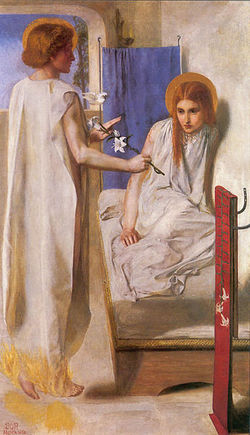
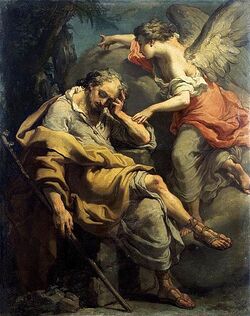
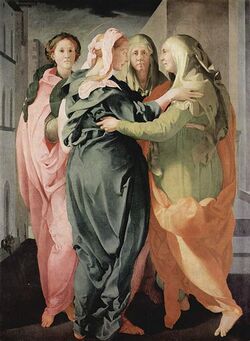

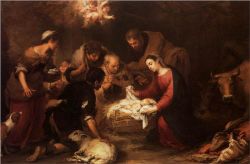
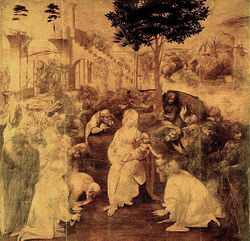
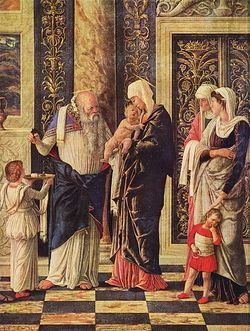
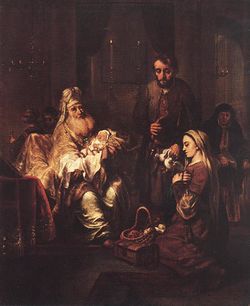
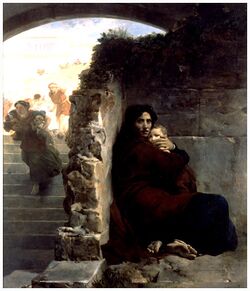
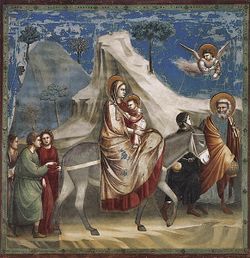
Nativity of Jesus refers to a series of episodes in the lives of Jesus of Nazareth and Mary of Nazareth, associated with Jesus' birth at Bethlehem, as narrated in the gospels of Matthew and Luke, and later Christian tradition.
- Genealogy of Jesus -- Annunciation to Mary -- Annunciation to Joseph -- Visitation of Mary -- Birth of Jesus -- Adoration of the Shepherds -- Adoration of the Magi -- Circumcision of Jesus -- Presentation of Jesus at the Temple -- Massacre of the Innocents -- Flight into Egypt
- Cf. Madonna and Child -- Joseph and Jesus -- Holy Family
< Life of Jesus : Nativity of Jesus -- Childhood of Jesus -- Jesus' Hidden Years -- Ministry of Jesus (Parables of Jesus, Miracles of Jesus) -- Passion of Jesus -- Resurrection of Jesus -- Relics of Jesus >
< Life of Mary of Nazareth : Mary's Early Life -- Nativity of Jesus -- Jesus' Hidden Years -- Mary and the Ministry of Jesus --- Mary and the Early Church -- Relics of Mary of Nazareth >
Overview
The historicity of the Nativity stories is largely disputed for three major reasons:
(a) The Gospels of Mark and John do not contain any narrative about the Nativity of Jesus at Bethlehem and seem to assume that Jesus was born at Nazareth.
(b) There are no recorded sayings of Jesus, which refer to his birth at Bethlehem, while Nazareth is commonly mentioned as his "home." In all ancient sources, Jesus is consistently identified as Jesus of Nazareth (and never as Jesus of Bethlehem).
(c) Both the Gospels of Matthew and Luke record the birth of Jesus at Bethlehem, and yet offer two distinct narratives. The two accounts, although containing some common elements, are difficult to harmonize and appear to be theologically motivated.
According to Matthew, Joseph and Mary lived at Bethlehem. When Mary's pregnancy was revealed, Joseph would have liked to dismiss her but an angel announced to Joseph in a dream the true origin of the child. A group of Magi came from the East, following a "star," to pay homage to the newborn "King of the Jews." Herod the Great was so angered that he ordered the killing of all infants at Bethlehem. Joseph, Mary and baby Jesus escaped the massacre as Joseph was alerted in a dream to leave Bethlehem to Egypt. They came back to the land of Israel only when Herod the Great died, but still afraid of his son Archelaus, settled at Nazareth in Galilee. Matthew's account seems motivated by the theological concern of presenting Jesus as the "new Moses," who in his early life repeated the experiences of the ancient patriarch, miraculously escaping death in his childhood (see Finding of Moses) and coming from Egypt to reveal the new covenant.
According to Luke, Joseph and Mary lived at Nazareth in Galilee. Mary received the annunciation of the birth of Jesus. When pregnant, she spent three months with her relative Elizabeth, who was also expecting a baby, John the Baptist. Joseph and Mary had to travel to Bethlehem to register for the census of Quirinius, at the time of the Emperor Augustus and King Herod (sic!). During that trip, Jesus was born in the manger as his parents could not find room in the inn. A group of shepherds came and paid homage to the newborn. Jesus then was circumcised and presented to the Temple of Jerusalem, before his parents traveled back to Nazareth. Luke seems motivated by different concerns; the Nativity of Jesus as the Savior of Humankind is located in the more cosmopolitan context of the Roman Empire and the relation of jesus with Jerusalem and the Temple is presented in non-conflicting terms.
The circumstances of the birth of Jesus remain obscure. Nothing is said in ancient sources about the date (or the season) when Jesus was born. The chronology is uncertain. The "star" (possibly, Halley's Comet) appeared in October 12 BCE, Herod the Great died in 4 BCE, and the census of Quirinius occurred several years later, in 6 CE, when Herod's son Archelaus was removed from office and Judea became a Roman province. The census' purpose was to calculate property for taxation; it does not make any sense that people had to go back to their birthplace to register. The custom of celebrating the birthday of Jesus on December 25 derives from the Christianization of a pagan festival; see Christmas.
The tendency of later Christian traditions, starting with the Protoevangelium of James, was to merge and harmonize the narratives of Matthew and Luke and add numerous legendary elements in the process. No Christian source provides any additional historical elements.
Some anti-Christian narratives developed as early as the 2nd century CE, which made Jesus the illegitimate son of Mary and a Roman soldier named Panthera. Evidence of the Panthera legend are in the work of the Pagan philosopher Celsius (quoted by Origen), and in later Rabbinic texts (especially the so-called Toledot Yeshu). The name Panthera comes possibly as a corruption of parthenos (virgin); the phase "son of parthenos was turn into a common Roman name, Panthera, to discredit the reputation of Jesus. All the material contained in these later Jewish traditions developed as a parody of the Christian accounts and does not contain any reliable historical information.
The Islamic tradition provides an alternative account of the birth of Jesus, that only partially overlaps the Christian narrative. According the the Qur'an, Maryam (=Mary of Nazareth) was not married when Isa (=Jesus of Nazareth) was born and was a virgin when Allah informed her through His angel Jibreel (=Gabriel) that she would give birth to the Messiah. Isa was then born miraculously from an act of God's will, like Adam or John the Baptist. Isa was born about 600 years before Prophet Muhammad in the area of the Bethlehem Valley "under a palm tree" (as the Qur'an says: "and the pangs of childbirth drove her [=Maryam) under a palm tree,” ch. 19:23). When Maryam returned to the Temple, Isa performed his first miracle by speaking miraculously as an infant from the cradle: "I am a servant of Allah (abd-Allāh). He has given me the Scripture and has made me a Prophet. And He has made me blessed wherever I may be and has not made me arrogant, or unblessed. Peace on me the day I was born, the day I die, and the day I shall be raised back to life." (19:30-33).
The majority of scholars tend to conclude that Jesus was born at Nazareth in the last years of the reign of Herod the Great, and that no reliable narratives have being preserved about his childhood. All narratives about the nativity of Jesus have more to do with questions about the identity of Jesus than with historical events.
Nativity of Jesus, in ancient sources
Gospel of Matthew
- Genealogy of Jesus
- Annunciation to Joseph
- Birth of Jesus
- Adoration of the Magi
- Massacre of the Innocents
- Flight into Egypt
Gospel of Luke
- Annunciation to Mary
- Visitation of Mary
- Birth of Jesus
- Adoration of the Shepherds
- Circumcision of Jesus
- Presentation of Jesus at the Temple
- Genealogy of Jesus
Protoevangelium of James
- Annunciation to Mary
- Visitation of Mary
- Annunciation to Joseph
- Birth of Jesus
- Adoration of the Magi
- Massacre of the Innocents (and Martyrdom of Zacharias)
Nativity of Jesus, in visual arts
The Christian iconographic tradition harmonized the Gospels narratives, creating a cycle of scenes from the Annunciation to Mary to the return of the Holy Family from the Flight into Egypt.
Annunciation to Mary (Rossetti, 1850)
Annunciation to Joseph (Gandolfi, 1790)
Visitation of Mary (Pontormo, 1529)
Birth of Jesus (Repin, 1894)
Adoration of the Shepherds (Murillo, 1668)
Adoration of the Magi (Leonardo, 1482)
Circumcision of Jesus (Mantegna, 1461)
Presentation of Jesus at the Temple (Eeckhout, 1671)
Massacre of the Innocents (Cogniet, 1834)
Flight into Egypt (Giotto, 1306)
Nativity of Jesus, in cinema
- The Star of Bethlehem (1912 Marston), feature film
- The Three Wise Men (1913 Campbell), short film
- The Birth of Our Saviour (1914 Brabin), short film
- Restitution (1918 Gaye), feature film
- Prince of Peace (1939 Carter), short film
- The Coventry Nativity Play (1947 BBC), TV film
- Il miracolo (The Miracle / 1948 Rossellini), short film
- The Coventry Nativity Play (1949 BBC), TV film
- A Time to Be Born (1951 BBC), TV film
- A Time to Be Born (1952 BBC), TV film
- Family Theatre: A Star Shall Rise (1952 Brahm), TV episode
- Studio One: The Play of the Nativity of the Child Jesus (1952 Schaffner), TV film
- A Time to Be Born (1953 BBC), TV film
- Away in a Manger (1954 Brooking), TV film
- Away in a Manger (1955 Brooking), TV film
- Joyful Hour (1960), TV film
- Play of the Week: Emmanuel (1960 Browning), TV film
- L'enfance du Christ (The Infancy of Christ / 1964 Schnur), TV film
- L'enfance du Christ (The Infancy of Christ / 1966 Münch), TV film
- The Nativity (1978 Kowalski), TV film
- The Very First Noel (2006 Cheney), animated short film
- The Nativity Story (2006 Hardwicke), feature film
- The Nativity (2010 Giedroyc), TV mini-series
- Nativity Film Marston.jpg
External links
Pages in category "Nativity of Jesus (subject)"
The following 200 pages are in this category, out of 205 total.
(previous page) (next page)1
- Journey of the Magi to Bethlehem (1461 Gozzoli), art
- Nativity (1577 Vos), art
- Missus est Gabriel Angelus (Annunciation to Mary / 1609 Bonini), sacred dialogue
- Die sieben Worte Jesu Christi am Kreuz (The Seven Last Words of Christ / 1645 Schütz), oratorio
- Presentation of Jesus in the Temple (1648 Champaigne), art
- La strage degli innocenti (1665 Bertali), oratorio
- Weihnachtshistorie (Christmas Story / 1665 Schütz), oratorio
- Herodes der Kindermörder (Herod the Child Murderer / 1675 Heinlein / Faber), oratorio
- In circumcisione Domini (1683 Charpentier), oratorio
- La fuga in Egitto (1697 Casini), oratorio
- I pastori al presepe (1721 Pistocchi / Pallavicini), oratorio
- Per la festività del santo natale (For the Feast of Christmas / 1727 Costanzi / Metastasio), oratorio
- Per la festività del santo natale (For the Feast of Christmas / 1727 Metastasio), libretto (oratorio)
- La circoncisione del santo bambino Gesù (1729 Chiocchetti), oratorio
- Weihnachtsoratorium (1734 Bach), oratorio
- Gesù presentato nel Tempio (1735 Caldara / Zeno), oratorio
- Componimento sagro per il SS.mo Natale di N.S. Gesù Cristo (For the Feast of Christmas / 1735 Mazzoni / 1727 Metastasio), oratorio
- Per la festività del santo natale (For the Feast of Christmas / 1737 Gregori / 1727 Metastasio), oratorio
- Per la festività del SS.mo Natale (For the Feast of Christmas / 1744 Chiarini / 1727 Metastasio), oratorio
- Il Verbo in carne (1748 Porpora), oratorio
- Per la festività del santo natale (For the Feast of Christmas / 1756 Sales / 1727 Metastasio), oratorio
- L’enfance du Christ (The Childhood of Christ / 1855 Berlioz), oratorio
- Oratorio de Noël (1858 Saint-Saëns), oratorio
- Balthasar (1889 France), novel
- Bethlehem (1894 Mackenzie), oratorio
- Presentation of Jesus at the Temple (1894 Tissot), art
- Sojourn in Egypt (1894 Tissot), art
- Il natale del Redentore (1899 Perosi), oratorio
- La strage degli innocenti (1900 Perosi), oratorio
- Bethlehem (1902 Housman), play
- Il natale: appunti d'esegesi e di storia (1903 Bonaccorsi), book
- La vie et la passion de Jésus-Christ (The Life and Passion of Jesus Christ / 1903 Zecca, Nonguet), feature film
- How They Came to Bethlehem (1911 Burrell), novel
- The Three Wise Men (1913 Campbell), short film
- The Dream of the Magi (1923 Cunninghame Graham), novel
- A Gift from the East (1928 Correll), novel
- The Affair at the Inn as Seen by Philo the Innkeeper & the Taxgatherer of Rome (1931 Finger), novel
- The Christ Child (1931 Petersham), children's novel
- La stella d'Oriente (1937 Jaccia), opera
- Prince of Peace (1939 Carter), short film
- The Coventry Nativity Play (1947 BBC), TV film
- The Coventry Nativity Play (1949 BBC), TV film
- A Time to Be Born (1951 BBC), TV film
- Amahl and the Night Visitors (1951 Schippers, Allen / @1951 Menotti), American (TV) production, video recording, world premiere (opera)
- A Time to Be Born (1952 BBC), TV film
- Family Theatre: A Star Shall Rise (1952 Brahm), TV episode
- Amahl and the Night Visitors (1952 Hoffman / @1951 Menotti), Bloomington (stage) production (opera)
- Amahl and the Night Visitors (1952 Schippers, Allen / @1951 Menotti), New York (stage) production (opera)
- Amahl and the Night Visitors (1952 Schippers, McIver / @1951 Menotti), American (TV) production (opera)
- Amahl and the Night Visitors (1952 Schippers, Sammarco / @1951 Menotti), New York (stage) production (opera)
- A Time to Be Born (1953 BBC), TV film
- Micha und die Könige (1953 Mutzenbecher, Duvoisin) = Amahl and the Night Visitors (1952 Frost, Duvoisin / @1951 Menotti), children's book (German ed.)
- Amahl and the Night Visitors (1953 Robinson / @1951 Menotti), British (TV) production (opera)
- Amahl e gli ospiti notturni = Amahl and the Night Visitors, Italian ed. (1953 Stokowski / @1951 Menotti), Florence (stage) production, sound recording (opera)
- Amahl und die nächtlichen Besucher = Amahl and the Night Visitors, German ed. (1953 Van Doorn / @1951 Menotti), German (TV) production (opera)
- Amahl e gli ospiti notturni = Amahl and the Night Visitors, Italian ed. (1954 Bartoletti / @1951 Menotti), Venice (stage) production (opera)
- Away in a Manger (1954 Brooking), TV film
- Amahl e gli ospiti notturni = Amahl and the Night Visitors, Italian ed. (1954 De Fabritiis / @1951 Menotti), Rome (stage) production (opera)
- Amahl et les rois Mages (Amahl and the Night Visitors / 1954 Muray, Pecnard / @1951 Menotti), children's book (French ed.)
- Amahl and the Night Visitors (1955 / @1951 Menotti), British (TV) production (opera)
- Away in a Manger (1955 Brooking), TV film
- Amahl e gli ospiti notturni = Amahl and the Night Visitors, Italian ed. (1955 Scaglia / @1951 Menotti), Italian (TV) production, video recording (opera)
- Amahl and the Night Visitors (1952 Frost, Duvoisin / @1951 Menotti), children's book
- Amahl and the Night Visitors (1956 Fluck / @1951 Menotti), British (stage) production (opera)
- Amahl and the Night Visitors (1956 Schippers, Jordan / @1951 Menotti), American (TV) production (opera)
- The Friendly Beasts (1957 Baker / Sidjakov), children's novel & art
- Amahl and the Night Visitors (1957 Post / @1951 Menotti), Australian (TV) production (opera)
- Amahl and the Night Visitors (1959 Balkwill / @1951 Menotti), British (TV) production (opera)
- Joyful Hour (1960), TV film
- Amahl en de nachtelijke bezoekers = Amahl and the Night Visitors, Dutch ed. (1960 Silberman / @1951 Menotti), Dutch (TV) production (opera)
- Amahl et les visiteurs de la nuit = Amahl and the Night Visitors, French ed. (1961 Bruck / @1951 Menotti), French (TV) production (opera)
- Amahl en de drie koningen (1962 Messelaar, Duvoisin) = Amahl and the Night Visitors (1952 Frost, Duvoisin / @1951 Menotti), children's book (Dutch ed.)
- Amahl et les visiteurs du soir (Amahl and the Night Visitors / 1962 Muray, Clouzot / @1951 Menotti), children's book (French ed.)
- Amahl and the Night Visitors (1963 Beattie / @1951 Menotti), Hempstead (stage) production (opera)
- Amahl y los Reyes Magos (Amahl and the Night Visitors / 1963 Díaz-Plaja, Cuixart / @1951 Menotti), children's book (Spanish ed.)
- The Lamb and the Child (1963 Frye / Duvoisin), children's novel & art
- Amahl and the Night Visitors (1963 Grossman / @1951 Menotti), American (TV) production, video recording (opera)
- Amahl and the Night Visitors (1967 Lockhart / @1951 Menotti), British (TV) production (opera)
- Die heilige Nacht (1968 Jüchen/Piatti), children's novel
- Herod, Do Your Worst (1968 Kelly), oratorio
- Amahl and the Night Visitors (1968 Kuntzsch / @1951 Menotti), Hamburg (stage) production (opera)
- Amahl and the Night Visitors (1969 Wilson / @1951 Menotti), New York (stage) production (opera)
- Amahl en die wyse manne (1970 Fluman, Duvoisin) = Amahl and the Night Visitors (1952 Frost, Duvoisin / @1951 Menotti), children's book (Afrikaans ed.)
- Amahl and the Night Visitors (1970 Keene / @1951 Menotti), New York (stage) production (opera)
- Amahl et les visiteurs de la nuit = Amahl and the Night Visitors, French ed. (1971 Marty / @1951 Menotti), Geneva (stage) production (opera)
- Jesús, el niño Dios (Jesus, the Child of God / 1971 Zacarías), feature film
- Two from Galilee (1972 Holmes), novel
- Amahl and the Night Visitors (1973 Bruschi / @1951 Menotti), New York (stage) production (opera)
- The Stableboy Who Stayed at Bethlehem (1974 Blythe), children's novel
- Amahl and the Night Visitors (1974 Braithwaite / @1951 Menotti), British (TV) production (opera)
- Amahl and the Night Visitors (1974 Manos / @1951 Menotti), Ann Arbor (stage) production (opera)
- ベツレヘムへの道 (Amahl and the Night Visitors / 1975 Isshiki, Sano / @1951 Menotti), children's book (Japanese ed.)
- Ochs und Esel (1975 Spang / Schmitt-Menzel), children's novel
- Amahl und die nächtlichen Besucher = Amahl and the Night Visitors, German ed. (1976 Wedekind / @1951 Menotti), Bremen (stage) production (opera)
- The Small One (1978 Bluth), animated short film
- Amahl and the Night Visitors (1978 López-Cobos / @1951 Menotti), American (TV) production, video recording (opera)
- The Christmas Pageant (1978 DePaola), children's novel & art
- Amahl and the Night Visitors (1978 Fletcher / @1951 Menotti), Texas (stage) production, sound recording (opera)
- L'Annunciazione (1978 Varotti / Belcari), oratorio
- Look to the One Beckoning Star (1979 Blythe), novel
- Amahl and the Night Visitors (1980 Henderson / @1951 Menotti), Utah (stage) production (opera)
- Amahl and the Night Visitors (1980 Smith / @1951 Menotti), St. Paul (stage) production (opera)
- Amahl und die nächtlichen Besucher = Amahl and the Night Visitors, German ed. (1980 Schwarz / @1951 Menotti), Vienna (stage) production (opera)
- Sun, Moon, Star (1980 Vonnegut / Chermayeff), children's novel & art
- Santa's Favorite Story (1982 Aoki / Gantschev), children's novel & art
- The Four Wise Men (1982 Tournier / Manheim), novel (English ed.)
- Per amore, solo per amore (1983 Festa Campanile), novel
- In the Days of Herod the King (1983 Sifler), oratorio
- The Donkey's Gift (1984 Coffey & Just), children's novel
- The Donkey’s Dream (1985 Berger), children's novel
- The Nativity Play (1985 Butterworth, Inkpen), children's novel
- All Those Mothers at the Manger (1985 Farber / Lloyd), children's novel & art
- Amahl et les visiteurs de la nuit (1986 Chapouton, Lemieux) = Amahl and the Night Visitors (1986 Frost, Lemieux / @1951 Menotti), children's book (French ed.)
- Poor Gabriella (1986 Forrester & Boulet), children's novel
- Amahl und die Könige aus dem Morgenland (1986 Krahé, Lemieux) = Amahl and the Night Visitors (1986 Frost, Lemieux / @1951 Menotti), children's book (German ed.)
- Amahl and the Night Visitors (1986 Syrus / @1951 Menotti), London (stage) production, sound recording (opera)
- Daniel's Gift (1987 Helldorfer / Downing), children's novel & art
- Amahl e gli ospiti notturni (1987 Tron, Lemieux) = Amahl and the Night Visitors (1986 Frost, Lemieux / @1951 Menotti), children's book (Italian ed.)
- The Little Hills of Nazareth (1988 Le Tord), children's novel
- Who Is Coming to Our House? (1988 Slate / Wolff), children's novel & art
- The Christmas Pageant (1989 Rogers), children's novel
- A Christmas Story (1989 Wildsmith), children's novel
- The Birth (1990 Edwards), novel
- The Story of Christmas (1991 Ray), children's novel
- The First Night (1993 Hennessy & Johnson, Fancher), children's novel & art
- The Christmas Donkey (1993 McClure), children's novel
- They Followed a Bright Star (1994 Heuck & Wensell), children's novel (English ed.)
- Christmas Lullaby (1994 Jewell & Vitale), children's novel
- The Crippled Lamb (1994 Lucado / Bonham), children's novel & art
- The Witness (1994 Westall / Williams), children's novel
- The First Christmas (1995 Hogrogian), children's novel & art
- The Story of Baby Jesus (1995 Jennings / Tourret), children's novel & art
- Bright Christmas: An Angel Remembers (1996 Clements / Kiesler), children's novel & art
- This Is the Star (1996 Dunbar / Blythe), children's novel & art
- Certain Poor Shepherds: A Christmas Tale (1996 Thomas / Davidson), children's novel & art
- L'Évangile de l'enfance (Luc 1-2) selon le proto-Luc (1997 Boismard), book
- Mary & the Baby Jesus (1997 Davidson / Lyon), children's novel & art
- One Small Lost Sheep (1997 Mills / Krudop), children's novel & art
- Il quarto re (The Fourth King / 1997 Reali), TV film
- The Shy Little Angel (1998 Brown), children's novel
- The Nativity: Mary Remembers (1998 Knowlton), novel
- Jacob's Gift (1998 Lucado / Hunt), children's novel & art
- Mary's First Christmas (1998 Wangerin / Ladwig), children's novel & art
- The Christmas Story (1999 Chancellor), novel
- Mary, Mother of Jesus (1999 Connor), TV film
- Come and See (1999 Mayper / Schuett), childen's novel & art
- The Last Straw (1999 Thury / Van Kampen), children's novel & art
2
- El Niño (2000 Adams / Sellars), oratorio
- Cat in the Manger (2000 Foreman), children's novel & art
- Hallelujah! (2000 Nikola-Lisa / Saint James), children's novel & art
- We Were There (2001 Bunting / Minor), children's novel & art
- Amahl and the Night Visitors (2001 Hickox / @1951 Menotti), Newcastle (stage) production (opera)
- Ochs und Esel (The Ox and the Donkey / 2001 Spang / Koopmans), children's novel & art
- The Little Boy's Christmas Gift (2001 Speirs), children's novel
- The Donkey's Christmas Song (2002 Tafuri), children's novel & art
- One Starry Night (2002 Thompson / Christiana), children's novel & art
- Amahl and the Night Visitors (2002 Hickox / @1951 Menotti), British (TV) production, video recording (opera)
- My First Story of Christmas (2003 Dowley / Langton), children's novel & art
- Amahal i els tres Reis (Amahl and the Night Visitors / 2003 Orihuela, Ruiz / @1951 Menotti), children's book (Catalan ed.)
- Amahal y los tres reyes (Amahl and the Night Visitors / 2003 Orihuela, Ruiz / @1951 Menotti), children's book (Spanish ed.)
- Room for a Little One (2003 Waddell / Cockroft), children's novel & art
- AD/BC: A Rock Opera (2004 Ayoade / Berry), TV production, video recording (opera)
- The First Christmas (2005 Agle), video
- (+) The Handmaid and the Carpenter (2006 Berg), novel
- The Very First Noel (2006 Cheney), animated short film
- (+) The Nativity Story (2006 Hardwicke), feature film
- The Nativity Story (2006 Hunt), novel
- Father and Son: A Nativity Story (2006 McCaughrean / Negrin), children's novel & art
- La sacra famiglia (The Holy Family / 2006 Mertes), TV mini-series
- Holy Family (2006 Vedovato), art
- Amahl and the Night Visitors (2006 Willis / @1951 Menotti), Nashville (stage) production, sound recording (opera)
- Magi (2007 Gilbert), novel
- La stella dei re (The Kings' Star / 2007 Jephcott), TV film
- The Nativity Story (2007 McCaughrean / Williams), children's novel & art
- A Christmas Beginning (2007 Perry), novel
- Amahl et les visiteurs de la nuit = Amahl and the Night Visitors, French ed. (2009 Fellay / @1951 Menotti), Geneva (stage) production (opera)
- Amahl and the Night Visitors (2009 Hopkins / @1951 Menotti), Fairbanks (stage) production (opera)
- No Room at the Inn: The Nativity Story (2009 Malone / Langdo), children's novel & art
- The Nativity (2010 Giedroyc), TV mini-series
- Amahl and the Night Visitors (2010 Illick / @1951 Menotti), Santa Fe (stage) production, video recording (opera)
- Die Weihnachtsgeschichte (2010 Schulze), children's novel
- Amahl e os visitantes da noite = Amahl and the Night Visitors, Portuguese ed. (2010 Suzuki / @1951 Menotti), São Paulo (stage) production (opera)
- The Christmas Journey (2010 VanLiere / Storrings), novel
- A Christmas Goodnight (2011 Buck / Wright), children's novel & art
- The Third Gift (2011 Park & Ibatoulline), novel
- One Starry Night (2011 Thompson / Bean), children's novel & art
- Unholy Night (2012 Grahame-Smith), novel
- Amahl and the Night Visitors (2012 / @1951 Menotti), Hawaii (stage) production (opera)
- Amahl and the Night Visitors / Amahl y Los Reyes Magos (2012 Rinaldi / @1951 Menotti), Miami (stage) production (opera)
- Amahl and the Night Visitors (2012 Rodriguez / @1951 Menotti), Baton Rouge (stage) production (opera)
- Amahl and the Night Visitors (2012 Tamarkin / @1951 Menotti), Charlottesville (stage) production (opera)
- Amahl and the Night Visitors (2012 Katsman / @1951 Menotti), Livermore (stage) production (opera)
- Amahl and the Night Visitors (2012 Xenelis / @1951 Menotti), Santa Rosa (stage) production (opera)
- Amahl e os visitantes da noite = Amahl and the Night Visitors, Portuguese ed. (2014 Figueiredo / @1951 Menotti), Rio de Janeiro (stage) production (opera)
- Amahl and the Night Visitors (2014 Hisey / @1951 Menotti), Bridgeport (stage) production (opera)
- Amahl and the Night Visitors (2014 Scarabino / @1951 Menotti), Argentine (stage) production (opera)
- Amahl and the Night Visitors (2014 Sensi Sellner / @1951 Menotti), Pittsburgh (stage) production (opera)
- Amahl und die nächtlichen Besucher = Amahl and the Night Visitors, German ed. (2015 Dissmeier / @1951 Menotti), Gera (stage) production (opera)
- Amahl and the Night Visitors (2015 Edewards / @1951 Menotti), Knoxville (stage) production (opera)
- Amahl and the Night Visitors (2016 Banks / @1951 Menotti), Alabama (stage) production (opera)
Media in category "Nativity of Jesus (subject)"
The following 9 files are in this category, out of 9 total.
- 1895 * Van Dyke (novel).jpg 333 × 499; 42 KB
- 1912 Marston (film).jpg 449 × 600; 92 KB
- 1951 * Menotti (opera).jpg 251 × 352; 36 KB
- 1955 Menotti (TV film).jpg 214 × 317; 19 KB
- 1965 * Lofts (novel).jpg 324 × 499; 36 KB
- 1977 * Brown.jpg 235 × 350; 12 KB
- 1978 Kowalski (TV film).jpg 266 × 475; 25 KB
- 1979 Till (film).jpg 300 × 548; 37 KB
- 2006 * Fletcher (novel).jpg 300 × 500; 48 KB





